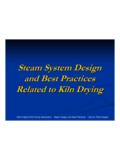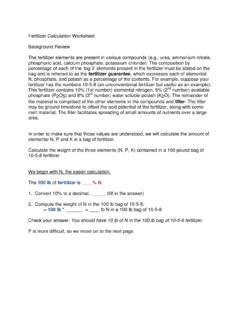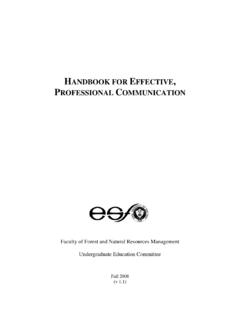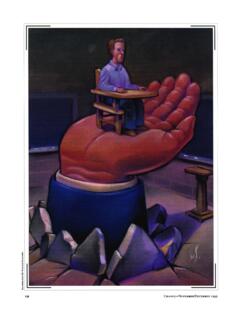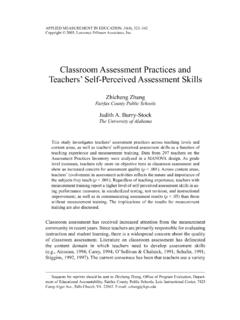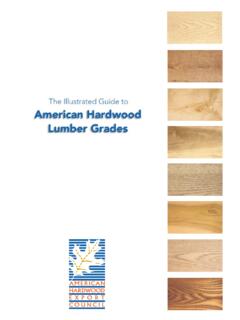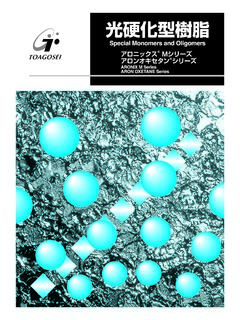Transcription of Introduction to the Basics of UV/EB Chemistry and Formulations
1 Introduction to the Basics of UV/EB Chemistry and Formulations SUNY ESF Radiation Curing Program RadTech NA Dr. Mike J. Idacavage Colorado Photopolymer Solutions September 9, 2015 Agenda Introduction to UV/EB Curing Basic Formulation strategy Oligomers Monomers Photoinitiators Cationic Cure Electron Beam Basics in Action 3D Printing 2 Energy curable Industrial Coatings 3 Energy curable Graphic Arts Applications 4 What is Energy Curing? Using UV energy, visible light, or low energy electrons as opposed to thermal, evaporative, or oxidative (air-dry) cure to form a coating, film or ink Types of energy used for energy curing: oUltra violet (UV): 200 400 nm oVisible light: typically 380 - 450 nm oElectron beam: low energy electrons 5 Note that the terms radiation curable or UV/EB curable may be used interchangeably.
2 Why Use Energy Curing? Productivity, Productivity, Productivity oSeconds to cure vs. minutes or hours Lower Overall Cost (per cured part) o100% solids, cure speed, recycling of coating, etc Single component formulas oEliminates mixing errors found in 2 component systems Regulatory Concerns (VOC emission) oAvoid solvent use in most cases Smaller equipment footprint oLess floor space needed Energy costs Did I mention Productivity? 6 Areas of Strength for UV/EB curable Examples: oScratch Resistant Coatings (plastic, paper up-grade) oOver Print Varnishes (OPV) oPrinting Inks (Litho, Flexo, Screen) oWood Coatings oElectronic & Fiber Optic Coatings oPhotopolymer Plates 7 UV/EB Curables can generate a high crosslink density network that results in a coating with high gloss and hardness, scratch and stain resistance and fast cure.
3 UV/EB Curing also works best with flat substrates. Areas for Improvement Adhesion to some metals, esp. during post-forming Adhesion to some plastics Tear resistance Low gloss in 100 % solid systems Low film weight for 100% solids Overall cure of 3-D parts 8 UV/EB CURING TYPES OF RADIATION USED UV - ultraviolet photons EB - low energy electrons 9 UV/EB CURING Chemistry Free Radical Polymerization through double bonds (Meth)Acrylate double bonds most common functionality Cationic Polymerization through epoxy groups Cycloaliphatic epoxies most commonly used 10 UV/EB CURING Chemistry Free Radical Curing - UV Photoinitiator absorbs UV light and generates free radicals Free radicals react with double bonds causing chain reaction and polymerization Cationic Curing - UV Photoinitiator absorbs UV light and generates a Lewis acid Acid reacts with epoxy groups resulting in polymerization 11 UV/EB CURING Chemistry Free Radical Curing - EB Electrons open double bonds initiating polymerization - no photoinitiator required Cationic Curing - EB Electrons decompose photoinitiator to form acid - photoinitiator is required for polymerization 12 UV CURING (Meth)Acrylated Resin(s)
4 Basic coating properties Monofunctional Monomer(s) viscosity reduction, flexibility Multifunctional Monomer(s) viscosity reduction, crosslinking Additives performance fine tuning Photoinitiator Package free radical generation 13 UV Light C U R E D P R O D U C T EB CURING Acrylated Resin(s) basic coating properties Monofunctional Monomer(s) viscosity reduction, flexibility Multifunctional Monomer(s) viscosity reduction, crosslinking Additives performance fine tuning 14 C U R E D P R O D U C T Electrons 15 Formulating for properties Some desirable properties for coatings: Adhesion Cure speed SARC (scratch & abrasion resistant coatings) Weatherability Flexibility Pigmented systems 16 Everything You Always Wanted to Know About UV/EB Formulating Formulation of EC Products 17 Formula Application Lamp Output All three aspects are interrelated FORMULATING A UV curable SYSTEM 18 OLIGOMER ADDITIVES MONOMERS PHOTOINITIATORS FORMULATING A UV curable SYSTEM 19 OLIGOMER ADDITIVES MONOMERS PHOTOINITIATORS OLIGOMER TYPES 20 (Meth)
5 Acrylated Epoxies Aliphatic Urethanes Aromatic Urethane Polyesters Acrylics Specialty Resins Characteristics fast curing, hard, solvent resistant, lower cost flexible, tough, non-yellowing, best weathering properties flexible, tough, lower cost than aliphatic urethanes low viscosity, good wetting properties good weathering properties, low Tg adhesion, special applications Epoxy Acrylate bisphenol A diglycidyl ether diacrylate OLIGOMERS CH2 CHCOCH2 CHCH2 OCCH3CH3 OCH2 CHCH2 OCCHCH2 OOHOHO21 Urethane Acrylate aliphatic urethane diacrylate OLIGOMERS CH2 CHCOROCNHCH2 NHCOR' OCNHCH2 NHCROCCHCH3 OOOOOOCH3CH3CH3CH3CH3CH322 FORMULATING A UV curable SYSTEM 23 OLIGOMER ADDITIVES MONOMERS PHOTOINITIATORS MONOMERS Monofunctional Monomer IBOA isobornyl acrylate C H 3 O C C H 3 C H 3 O C C H 2 H 24 MONOMERS Difunctional Monomer TRPGDA tripropylene glycol diacrylate CH2 CHCO(C3H6O)3 OCCHCH2O25 MONOMERS Trifunctional Monomer T M P TA trimethylol propane triacrylate CH3CH2 CCH2 OCCHCH2 OOCH2 CHCOCH2 OCH2 CHCOCH226 Cure Speed 27 Monomer Selection Flexibility Adhesion Visc.
6 Reduction Residual Uncured Mono- Func. Di- func. Trifunc. & Higher Like all generalizations, these trends are usually, but not always, true FORMULATING A UV curable SYSTEM 28 OLIGOMER ADDITIVES MONOMERS PHOTOINITIATORS ADDITIVES Pigments Fillers Defomers Flatting Agents Wetting Agents Slip Aids 29 FORMULATING A UV curable SYSTEM 30 OLIGOMER ADDITIVES MONOMERS PHOTOINITIATORS Photoinitiators 31 Terms/Glossary max (pronounced lambda max ) The wavelength at which photoinitiator absorbs the most energy; also known as peak absorbance absorbance The amount of light a material takes in as opposed to reflecting or transmitting it cure The conversion of unreacted material to reacted material ; transformation of monomers and oligomers to a polymer network; in practical terms, usually the point at which the wet material reaches a mar free state (or any other property of interest) photons A quantum of light; a packet of light energy polymerization The reaction by which monomers (and oligomers) are converted to high molecular weight materials (polymers) radical AKA free radical, molecule fragment with 1 unpaired electron.
7 Not an ion (has no charge) transmission The amount of light passing through a material ; the ratio between the outgoing (I) and the incoming intensity (Io), %T = (I/Io) x 100 32 Why Are PI Necessary? PI Characteristics Absorb UV light or electrons to form active species (radicals or acids) Add to monomer/oligomer to start cure process (polymerization) Different PI absorb UV light at different wavelengths Match PI max with UV lamp output Only reacts with UV-Vis energy, not heat Long pot life/shelf life 33 Initiation System is irradiated, reactive species (free radicals) created Propagation Oligomers and monomers add to the growing polymer chain, creating a high MW network Termination Two radicals combine to stop the chain reaction Photoinitiators can be a factor in initiation and termination UV Radical Polymerization 34 Initiation Process System is irradiated and the photoinitiator absorbs some of the incoming energy Photoinitiator forms one or more free radicals A free radical then combines with an acrylate to form a new radical that is the active species for the growing polymer UV polymerization is line-of-sight only shadowed areas very hard to cure Initiation 35 Propagation Process Referred to as a chain reaction Propagation Free radical on end of polymer chain Reacts with an acrylate to make a new radical 36 Termination Process Two radicals (active species, growing chains.)
8 PI fragments) combine and the polymerization stops If PI concentration is too high, the radicals from the PI can contribute to a high termination rate A high termination rate can lead to Greater levels of unreacted material Poor physical properties ( low adhesion, greater marring, poor tensile properties) Termination 37 Initiation Propagation Termination Summary I 2 I UV Energy I + M IM IM + M IMM + M IMM IMMM P~M + M~P P~M-M~P P~M + I P~M-I -OR- IMMM + M IMMMM I = Initiator M = Monomer (or any acrylate) P = Polymer chain 38 Classes of Photoinitiators Photocleavage (unimolecular PI) a-cleavage PI - Adsorbs light and fragments to form the radicals which initiate polymerization. Photoabstraction (bimolecular PI) Hydrogen abstraction PI - Adsorbs light and abstracts hydrogen from another molecule (photoactivator) which produces radicals.
9 Amine synergist (photoactivator) - Donates a hydrogen to the photosensitizer to produce the radicals which initiate polymerization. Photoinitiator, photosensitizer, and photoactivator are often used as different words for photoinitiators even though they are not the same 39 Photoinitiator Selection Absorption characteristics of photoinitiator and formulated system Pigmentation Spectral output of uv lamps Oxygen inhibition Weatherability (yellowing) Handling (liquid vs. solid) Toxicity Cost 40 Matching PI with UV lamp Different UV lamps emit energy in different part of the spectrum Need to match absorbance of the PI with the output of the lamp for highest efficiency 41 PI / Lamp Output Match(Additol CPK / Fusion "H" bulb)20021022023024025026027028029030031 0320330340350360370380390400410420430440 450 Good absorbance (PI) + Good energy output ("H" bulb) = Good matchUV-LED Output vs.
10 Mercury Lamp Oxygen inhibition Oxygen can inhibit (slow down) the cure speed of coatings and inks, especially in thin layers Solutions: Cure under an inert (N2) atmosphere Thiol-Enes Cationic Chemistry Amine synergists Increase light intensity/duration (increase number of free radicals) 43 Cationic Cure 44 CATIONIC CURING MECHANISM Initiation (Light & Heat) ORH+MF6-ORH+ORORRHO+initiation h photoinitiatorHOR+45 CATIONIC CURING MECHANISM Polymerization (Chain Reaction; Heat) polymerizationORORRHO+ORRHOORROn+chain reactionmOR46 Radical vs. Cationic 47 Radical Cationic wide variety of raw materials more limited raw materials inhibited by oxygen not inhibited by oxygen not inhibited by high humidity inhibited by high humidity not inhibited by basic materials inhibited by basic materials full cure in seconds full cure in hours shrinkage - greater shrinkage - less adhesion - less adhesion - greater depth of cure - greater depth of cure - less cost - less cost - greater UV/EB market share - 92-94% UV/EB market share - 6-8% UV Cationic Curing UV Light Cycloaliphatic Epoxide(s) basic coating properties Polyol(s) crosslinking, flexibility Epoxy/Vinyl Ether Monomer(s)
